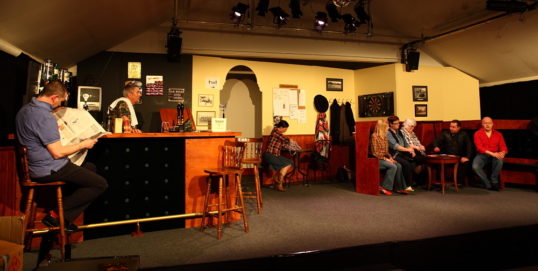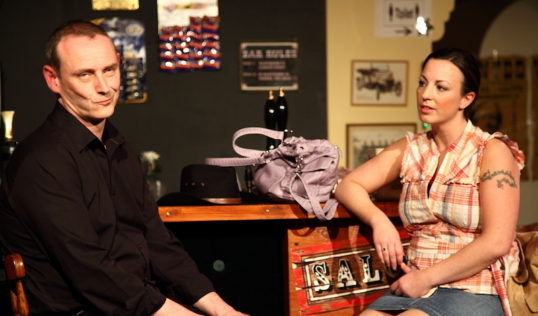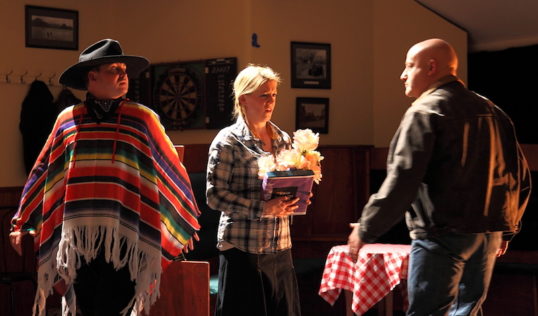Æ Review – A Fistful of Mondays
★★★☆☆
St Ninian’s Church Hall: Tue 12 – Sat 16 April 2011.
Review by Thom Dibdin
It’s a classic case of comedic love and loss up at Comely Bank this week, with a healthy dose of line dancing thrown in, as Edinburgh Theatre Arts stage Joe Graham’s comedy of small town social life: A Fistful of Mondays.
Opening up the tiny stage of St Ninian’s Hall as wide as they can, the company have converted it to Walbeswick Sports and Social Club. An ailing institution, thanks to the local pub’s conversion to a super-sizing food’n’booze palace.
If barkeep and Club Secretary Barry can’t beat them on portion size, he’s got other tricks up his sleeve. And much to the dismay of his only real regular, the socially inept divorcee Tom Jones, he has convinced dance teacher Annie to use the premises for her Monday Night All Star Line dancing Club.
Set over a succession of Monday nights, Graham’s script pushes the comedy high up the agenda and underpins it with a strong line of romance. It’s a structure which director Edith Peers uses to excellent effect, manipulating the petty squabbles and clashing personalities of the tiny – and potentially dwindling – line dancing club, while allowing moments of individual performance to shine.
There is more depth too, with the comedy cut through with the incongruity of the small town society bemoaning the loss of its institutions to Americanisation on the one hand but embracing their cultural exports on the other. Indeed, it is that small town attitude which plays a big part in what makes this such fun.
Colin McPherson is the real treat to watch as Tom Jones. He not only carries of the expected Not Unusual kind of quips with a naturalistic flair that keeps the comedy of the moment, but he builds the character excellently from cynical bystander to fully-involved participant in the Monday night rituals.
idiosyncratic and slightly mercurial
His partner at the bar, David Gibson, has the utterly crucial role to play as Barry. His succession of excellent loud shirts puts him apart – indeed Fran Morrice’s costume decisions are impeccable throughout – as an idiosyncratic and slightly mercurial character.
One moment he is the confiding best pal, pushing the potential romantic opportunities afforded by the various female members of the club to Tom, the next he is bemoaning the club’s failure to spend at the bar as he ups the ante with increasingly desperate attempt to keep them coming back.
Leading the line as Annie, Cari Silver has the tricky task of creating a personality for her rather underwritten character amidst the overwritten members of the line dancing club. It is to her immense credit that she succeeds, turning the play around as it moves towards its climax as she produces some hidden depths of character while keeping it neutral over the early acts.
As for rest of the cast, playing the various members of the club, their characters are there for the taking. Stuart Mitchell as the poncho-wearing film-buff Ronald, who likes to be called Clint on Monday nights; Danny Farrimond as the camp Duncan with a mouth full of bitchy queen remarks; Margaret McPherson as Sophie, running away from an inattentive husband; Jean Anthony as ancient Mary with her various sets of false teeth; and Lisa Moffat as the totally inept dancer Carol, all make the most of what they have to work with.
Hidden tragedy
What increases the interest, both in terms of the comedy itself but also in the quality of the production, is that amidst the sketch-style set-pieces and the easy quips of the line dancing routines, each of these characters is shown to have their own, hidden tragedy.
It’s not completely perfect as a production. The wordy script forces a few unintentional longueurs as the lines spiral away. There is also the question of using the lighting to mark out which part of the playing area the audience should be concentrating on. Peers has had to make tricky directorial decisions on the wide stage, to ensure that continued performance does not become a distraction to the real performance taking place on the other side of the stage. Decisions that would have been better enhanced with more subtle lighting available to the company.
Not that this impinges much on what is a fine night out. Indeed, the two and a half hours whizz by, the love interests are not nearly as obvious as they first appear to be, and the underlying issues are well worked through.
Run ends Saturday 16 April

The wide-open set of the Edinburgh Theatre Arts production of A Fistful of Mondays. Pic: Stefan Heumann
ENDS






















